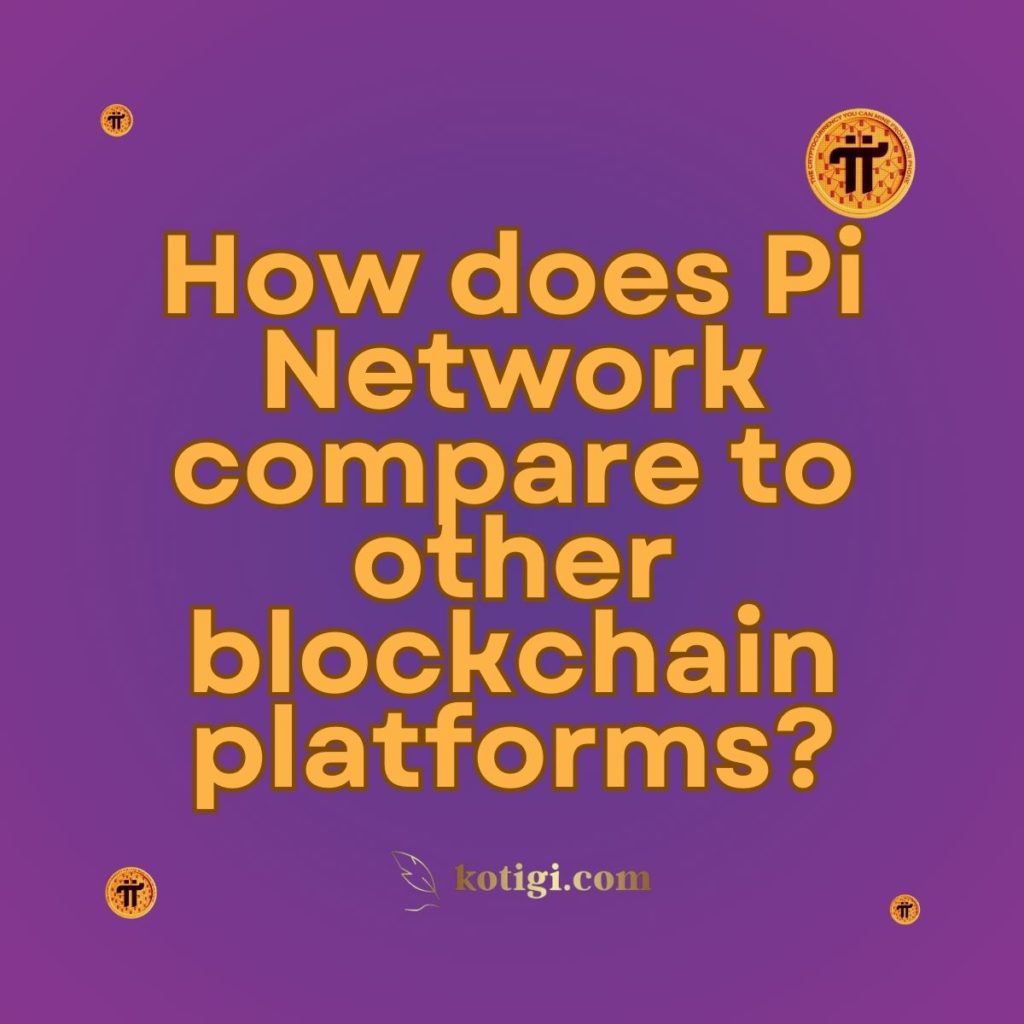
Here’s a comparison table that highlights key differences between Pi Network and other blockchain platforms:
| Aspect | Pi Network | Other Blockchain Platforms |
|---|---|---|
| Mining Methods | Mobile mining using smartphones, energy-efficient | Traditional PoW (e.g., Bitcoin) with energy-intensive mining; PoS (e.g., Ethereum 2.0) with reduced energy consumption |
| Scalability | Gradual scaling with plans for a future mainnet launch | Varied approaches: Bitcoin faces scalability issues; Ethereum is improving with sharding and Ethereum 2.0 |
| Decentralization | Initially centralized, transitioning to a decentralized model | Typically fully decentralized (e.g., Bitcoin, Ethereum) |
| Security | Regular audits, encryption, and gradual decentralization | Established security measures: cryptographic protocols, consensus mechanisms |
| Community and Ecosystem | Strong community focus, rewards for participation and expansion | Active communities with different engagement levels; diverse ecosystems (e.g., Ethereum for dApps) |
| Environmental Impact | Energy-efficient mobile mining | Traditional PoW blockchains have high energy consumption; PoS and other models aim to reduce environmental impact |
| Use Cases and Goals | Accessible cryptocurrency, financial inclusion, community-driven growth | Varied: Bitcoin for digital currency, Ethereum for smart contracts and dApps, Cardano for scalability and governance |
| Regulation and Compliance | Developing regulatory and compliance framework | Established blockchains face regulatory scrutiny; varying levels of regulatory engagement |
This table provides a snapshot of how Pi Network compares to other blockchain platforms in terms of key aspects such as mining methods, scalability, and decentralization.
How does Pi Network compare to other blockchain platforms?
Pi Network introduces a unique approach to blockchain technology, particularly in its focus on accessibility, mobile mining, and community-driven growth. To understand how Pi Network compares to other blockchain platforms, it’s essential to examine various aspects such as mining methods, scalability, decentralization, security, and overall goals.
1. Mining Methods
- Pi Network: Pi Network offers a novel mobile mining approach, allowing users to mine Pi coins using their smartphones without consuming significant energy or requiring expensive hardware. This makes mining accessible to a broader audience compared to traditional blockchain platforms.
- Other Blockchain Platforms: Most established blockchain platforms, like Bitcoin and Ethereum, rely on energy-intensive Proof of Work (PoW) mining or Proof of Stake (PoS) systems. Bitcoin, for example, requires specialized hardware (ASICs) and consumes significant energy, while Ethereum’s PoW method is also resource-intensive. In contrast, Pi Network’s mobile mining model aims to be more user-friendly and environmentally sustainable.
2. Scalability
- Pi Network: Pi Network is designed to scale gradually. Initially, it operates in a test phase where mining and network growth are managed to prepare for a future mainnet launch. The network’s architecture aims to handle millions of users efficiently, with plans for scalability as it transitions to a decentralized system.
- Other Blockchain Platforms: Scalability varies widely among blockchain platforms. Bitcoin faces scalability issues due to its block size and transaction processing limitations. Ethereum has worked on solutions like sharding and Ethereum 2.0 to enhance scalability. Other platforms, such as Binance Smart Chain and Solana, have adopted different strategies to achieve high transaction throughput and low latency.
3. Decentralization
- Pi Network: Pi Network’s decentralization is a work in progress. The network is initially managed by a central team but plans to transition to a fully decentralized model as it evolves. The aim is to eventually implement decentralized governance, allowing users to participate in decision-making processes.
- Other Blockchain Platforms: Many established blockchains, such as Bitcoin and Ethereum, are already fully decentralized, with no single entity controlling the network. Decentralization is a core principle of these platforms, ensuring that power and control are distributed across a global network of nodes.
4. Security
- Pi Network: Pi Network focuses on security through regular audits, encryption, and a gradual transition to decentralization. The mobile mining model reduces the risk of hardware-related attacks but requires robust measures to protect user data and network integrity.
- Other Blockchain Platforms: Established blockchains like Bitcoin and Ethereum have well-tested security measures, including strong cryptographic protocols and consensus mechanisms. Bitcoin’s security is bolstered by its large network of miners, while Ethereum is enhancing security through upgrades in Ethereum 2.0.
5. Community and Ecosystem
- Pi Network: Pi Network emphasizes community involvement and growth. It rewards users for mining and expanding the network, creating a strong community-driven approach. The network also incentivizes user participation through a referral system and planned governance mechanisms.
- Other Blockchain Platforms: Many blockchain platforms also have active communities, but the level of community involvement and reward structures vary. For example, Ethereum has a developer community that contributes to its ecosystem through dApps and smart contracts, while platforms like Polkadot focus on interoperability and community governance.
6. Environmental Impact
- Pi Network: Pi Network’s mobile mining model is designed to be energy-efficient, addressing environmental concerns associated with traditional mining practices. By reducing the energy consumption required for mining, Pi Network aims to offer a more sustainable alternative.
- Other Blockchain Platforms: Traditional PoW blockchains, like Bitcoin, face criticism for their high energy consumption and environmental impact. Some platforms are transitioning to PoS or hybrid models to reduce energy usage. Ethereum’s shift to Ethereum 2.0 is a step toward more sustainable practices.
7. Use Cases and Goals
- Pi Network: Pi Network’s primary goal is to make cryptocurrency accessible to everyone and build a strong community. It aims to create a user-friendly platform that fosters financial inclusion and democratizes cryptocurrency mining.
- Other Blockchain Platforms: Different blockchains have varying goals and use cases. Bitcoin is primarily a digital currency and store of value, while Ethereum enables smart contracts and decentralized applications (dApps). Platforms like Cardano and Polkadot focus on scalability, interoperability, and creating decentralized ecosystems for diverse applications.
8. Regulation and Compliance
- Pi Network: Pi Network is still in the process of developing its regulatory and compliance framework. As it prepares for its mainnet launch, it will need to address legal and regulatory considerations to ensure compliance with relevant laws and regulations.
- Other Blockchain Platforms: Established blockchains have varying levels of regulatory engagement. Bitcoin and Ethereum have faced regulatory scrutiny, but they are generally recognized as significant players in the cryptocurrency space. Other platforms, like Ripple, have faced specific legal challenges related to regulatory compliance.
Conclusion
Pi Network distinguishes itself from other blockchain platforms through its focus on mobile mining, community-driven growth, and accessibility. While it shares some common goals with other blockchain platforms, such as decentralization and security, its unique approach to mining and emphasis on inclusivity set it apart. As Pi Network continues to develop and transition to a fully decentralized system, its impact on the cryptocurrency market will become more apparent, offering an alternative model to traditional blockchain platforms.





